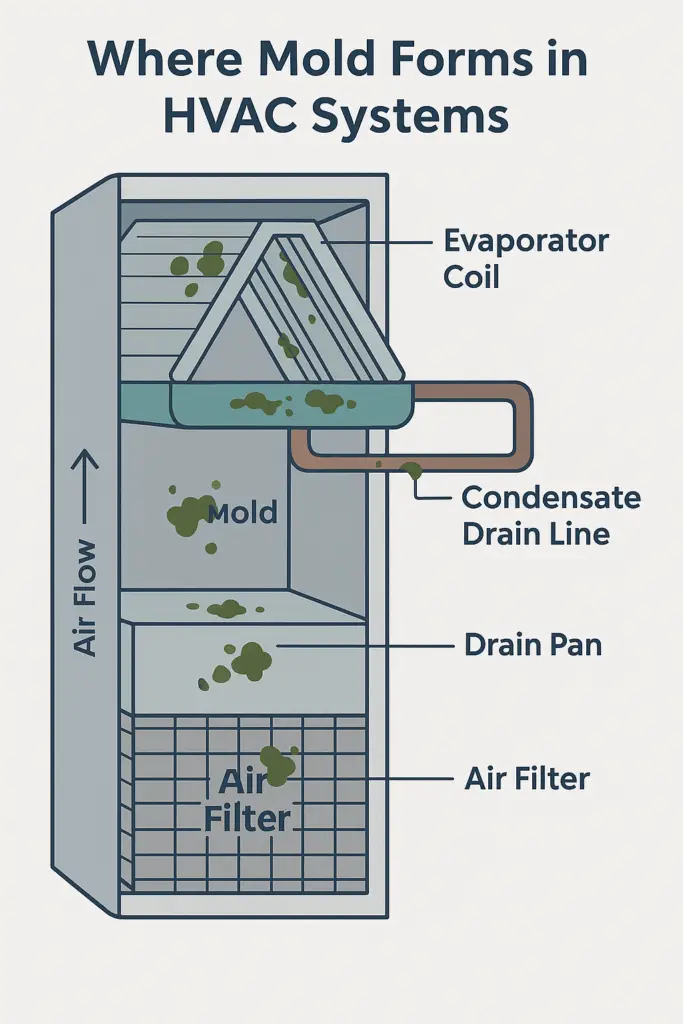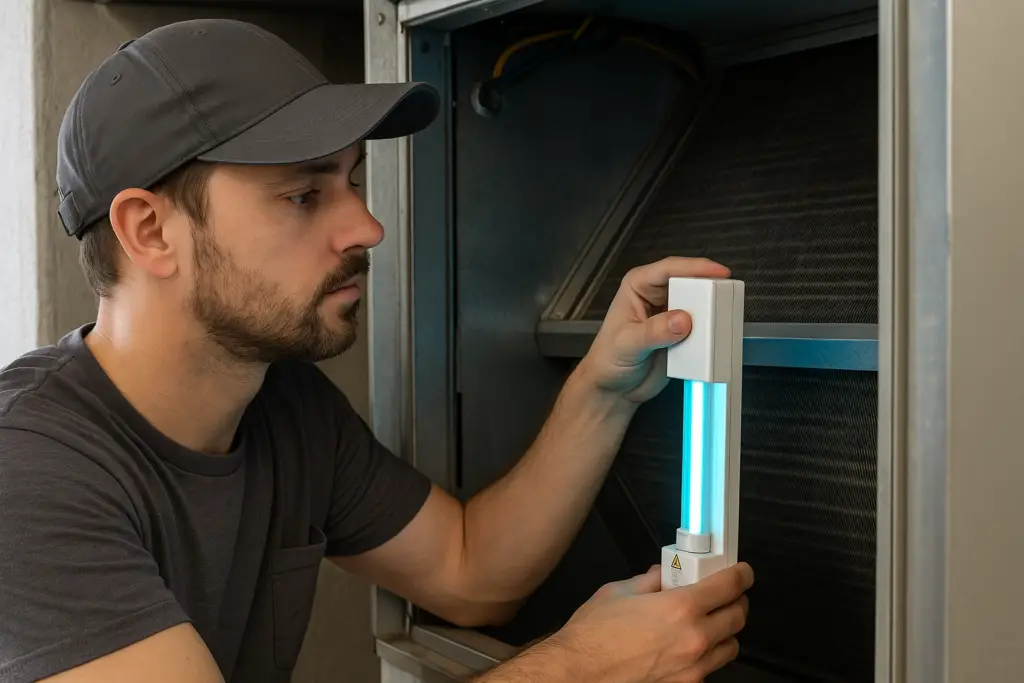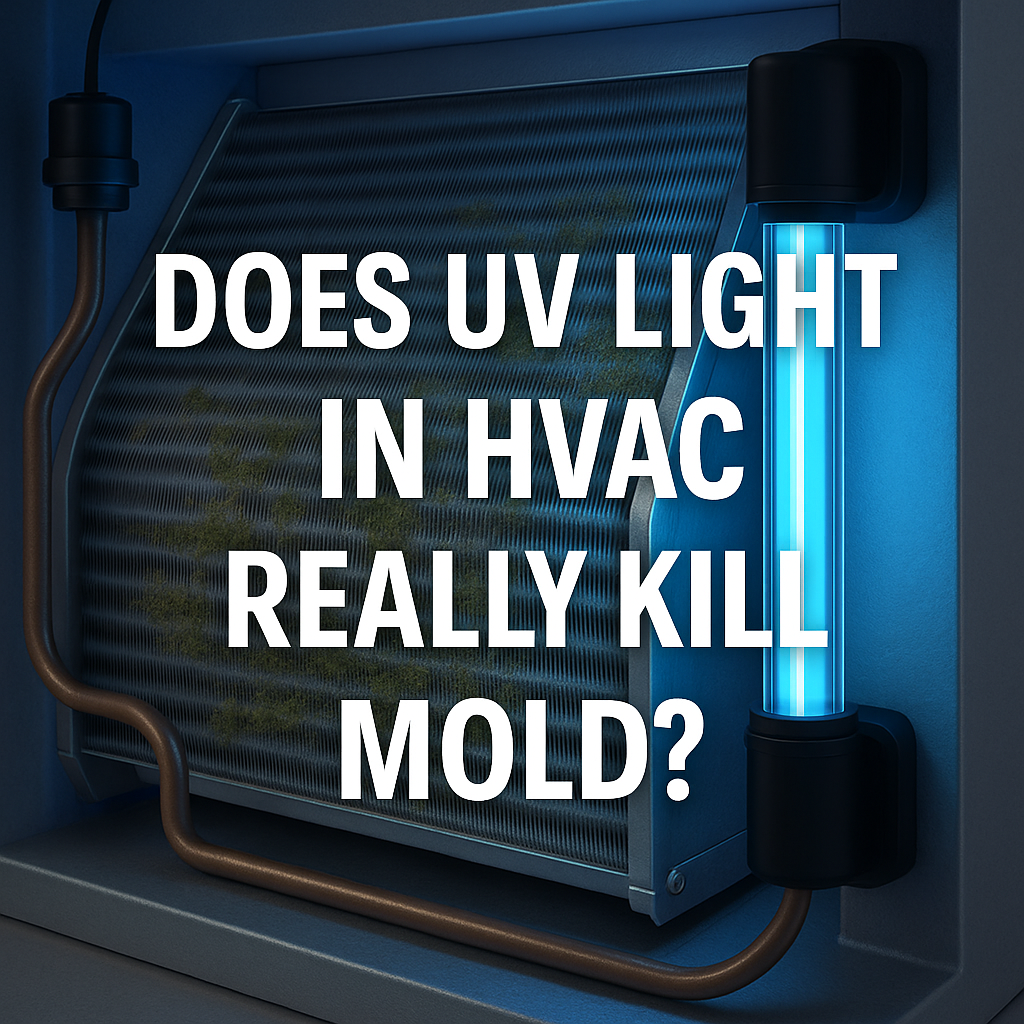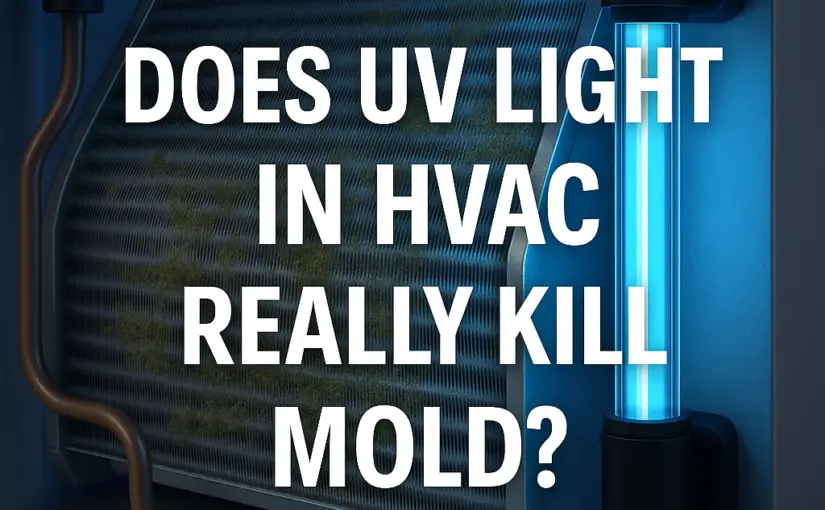Yes, UV light in HVAC systems can kill mold by disrupting its DNA, preventing growth and reproduction. UV-C light is especially effective at neutralizing mold on surfaces like evaporator coils and drain pans, though its effectiveness depends on placement, intensity, and exposure time.
🎯 Read the full guide here:
Pros and Cons of UV Light in HVAC – Are the Benefits Worth the Cost?
Table of Contents
How UV Light Fights Mold in Your HVAC System
Ultraviolet (UV) light, particularly UV-C, is increasingly used in HVAC systems to combat mold growth and improve indoor air quality. But how exactly does it work—and how effective is it?
If you’ve already read our article on the Pros and Cons of UV Light in HVAC, this deeper dive explains how UV-C light targets mold, what it can and can’t do, and how to get the most out of your installation.
How UV-C Light Targets Mold
UV-C light operates at a wavelength of around 254 nanometers—just the right range to penetrate and damage the DNA of microorganisms like mold and bacteria. When UV-C light shines on mold:
- It breaks the mold’s DNA, rendering it unable to reproduce.
- It kills active spores on exposed surfaces.
- It halts further growth by sterilizing key moisture zones like coils and pans.
Think of it like a silent air guardian, constantly sterilizing the darkest, dampest corners of your HVAC system where mold would otherwise thrive

Where Mold Hides in Your HVAC System
Mold doesn’t grow just anywhere—it needs moisture, darkness, and stagnant air. Unfortunately, your HVAC system provides the perfect recipe in a few key places:
- Evaporator coils: Constantly damp and cool—prime territory for mold.
- Drain pans: Collect moisture, especially if clogged or uncleaned.
- Ductwork and filters: Dust buildup + moisture = mold habitat.

What the Research Says About Mold & UV
Studies from institutions like the CDC and Journal of Applied and Environmental Microbiology have shown that UV-C light can significantly reduce microbial contamination in HVAC systems—especially when used in hospitals and commercial buildings where cleanliness is crucial.
Results vary depending on exposure time and installation quality, but with proper setup, UV-C can reduce mold and bacterial growth by up to 90% on coils and interior surfaces.
Realistic Expectations: What UV Can and Can’t Do
UV light is powerful, but it’s not a miracle worker. Here’s a quick comparison:
| ✅ What UV Can Do | ⚠️ What UV Can’t Do |
|---|---|
| Kill mold on coils and exposed surfaces | Remove mold from hidden ductwork or walls |
| Prevent mold regrowth when left on 24/7 | Disinfect through dust, insulation, or buildup |
| Improve air quality and HVAC efficiency | Replace cleaning, maintenance, or filter changes |

Case Example: UV Light Made a Long-Term Difference
A homeowner in Arizona noticed a musty odor coming from their vents. A local HVAC technician inspected the system and discovered mold buildup on the evaporator coil and in the drain pan. They cleaned the affected components and installed a UV-C light directed at the coil.
Three months later, a follow-up inspection showed zero mold regrowth. The odor was gone, and the homeowner reported fewer respiratory issues in the house.

Best Practices to Maximize UV Effectiveness
UV systems only work if they’re installed and maintained properly. Here’s how to make sure you’re getting the most out of yours:
- Install near the evaporator coil—that’s the prime mold zone.
- Use a system rated for 24/7 operation—intermittent UV exposure is less effective.
- Keep the surfaces clean—dirt and debris block UV penetration.
- Change the bulb every 12 months—UV intensity fades over time.
- Consider dual-bulb systems—some cover both coil and air stream.
- Pair with routine filter changes and duct cleaning to maintain optimal airflow and hygiene.
Avoid These Mistakes When Using UV Light in HVAC
- Installing in the wrong location: Bulbs mounted far from the coil won’t be effective against mold.
- Not replacing bulbs regularly: Most UV-C bulbs lose effectiveness after 9–12 months even if they still glow.
- Skipping coil cleaning before install: UV can’t shine through grime or buildup—always clean first.
- Thinking UV replaces filters: UV only kills microorganisms. It doesn’t remove dust, allergens, or pet hair.
How to Choose the Right UV Light for Your System
Not all UV-C systems are created equal. Here’s what to look for:
- High-output bulbs: Especially important for large or high-humidity homes.
- Coil-targeted design: Units designed to shine directly on the evaporator coil are most effective.
- Continuous-operation support: Make sure your system is meant to run 24/7.
- Easy bulb replacement: Consider systems with accessible bulb access and affordable replacements.
- Warranty and support: Look for at least a one-year warranty and tech support availability.
FAQ: What People Ask About UV and Mold
Does UV light kill mold spores in the air?
Yes, but only if the spores pass directly through the UV light’s coverage area. Most systems are more effective on surface mold than airborne spores.
How long does it take UV light to kill mold?
It can take a few minutes to several hours depending on the intensity, distance, and exposure time. Continuous operation provides the best results.
Is UV light safe for HVAC systems?
Yes. UV systems are installed inside the air handler and do not emit radiation outside the HVAC cabinet. Just avoid looking at the bulb directly.
Can UV light damage HVAC components?
Not typically. When installed correctly, UV-C light does not harm metal, plastic, or wiring. However, prolonged direct exposure to certain plastics or filters may cause fading or brittleness over time—this is rare with modern systems.
Do UV lights help with allergies or asthma?
They can. By reducing mold, bacteria, and some airborne pathogens, UV lights can improve overall air quality. This may ease symptoms for people sensitive to microbial pollutants, though UV light doesn’t remove dust, pollen, or pet dander.
What maintenance does a UV system need?
The main task is replacing the bulb once a year. Even if it still glows, UV-C effectiveness fades after 9–12 months. It’s also smart to clean the surrounding area to keep dust from blocking the light.
Can I install a UV light in my HVAC system myself?
Some homeowners with experience can install coil-mounted UV kits, but professional installation is recommended. Proper placement, electrical safety, and UV shielding are important for safe and effective operation.
Final Thoughts: Is UV Light Worth It for Mold Control?
If mold is a concern in your home—or you simply want to keep your HVAC system cleaner—UV light is a strong long-term investment. It complements your air filter, reduces microbial buildup, and can improve your home’s overall air quality.

It’s not a mold remover, but it’s an excellent mold preventer when used correctly. Combined with proper maintenance, UV light can make a noticeable difference in comfort, odor control, and even health.
Next Step?
👉 Read: Pros and Cons of UV Light in HVAC. Is it Worth it?





